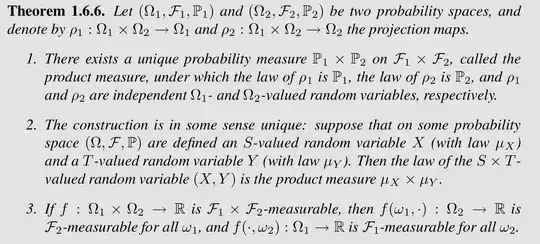I'm reading part 3. of below theorem:

Summary: Let $\left(\Omega_{1}, \mathcal{F}_{1}\right)$ and $\left(\Omega_{2}, \mathcal{F}_{2}\right)$ be two measurable spaces, and $\mathcal{F}_{1} \otimes \mathcal{F}$ their product $\sigma$-algebra. If $f: \Omega_{1} \times \Omega_{2} \rightarrow \mathbb{R}$ is $\mathcal{F}_{1} \otimes \mathcal{F}_{2}$-measurable, then $f\left(\omega_{1}, \cdot\right): \Omega_{2} \rightarrow \mathbb{R}$ is $\mathcal{F}_{2}$-measurable for all $\omega_{1}$, and $f\left(\cdot, \omega_{2}\right): \Omega_{1} \rightarrow \mathbb{R}$ is $\mathcal{F}_{1}$-measurable for all $\omega_{2}$.
My understanding: Let $\rho_{1}: \Omega_{1} \times \Omega_{2} \rightarrow \Omega_{1}$ and $\rho_{2}: \Omega_{1} \times \Omega_{2} \rightarrow \Omega_{2}$ be the projection maps. Then $\rho_1, \rho_2$ are measurable. Let $f_1 (\cdot) := f\left(\omega_{1}, \cdot\right)$. For a Borel set $B \subseteq \mathbb R$, $$f_1^{-1} (B) = \rho_2 (f^{-1} (B) \bigcap ( \{\omega_1\} \times \Omega_2 )).$$
I guess $\{\omega_1\} \times \Omega_2$ and the image of a measurable set through $\rho_1$ are not neccessarily measurable. So I think the statement given by the author may not be correct. Could you clarify my confusion?